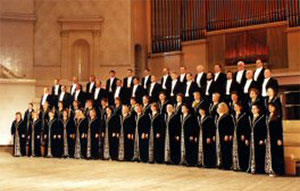by Timothy Robson

The 50-voice choir demonstrated all the hallmarks of fine Russian choral singing: a clear, focused sound with seamless legato and blend. The tone was never forced, even at higher volumes. And, of course, there were those very low basses that are the DNA of Russian choral singing. There were times when the conductor lingered over particularly luscious chords with low notes so that the audience could revel in the sound. The choir was so well trained (although they did sing from scores) that Polyansky conducted with minimal gestures.
Much of the music was unfamiliar, especially the Russian works. There were brief printed program notes supplied by the artists, but the notes were primarily biographical information about the composers, with nothing about the actual works being performed. Neither were there texts nor translations. So the audience had to content themselves with the sounds of the chorus, without reference to the context of the music. This is a case where the museum might have engaged another writer to expand on the information presented.
But whether the individual works themselves were unfamiliar, most of the names were: Bortniansky (18th century), Titov (17th century), Taneyev (late 19th-early 20th century), and Tchaikovsky. That composer was represented by three short works, including the famous carol “The Legend,” known in England and the United States as “The Crown of Thorns.” At the beginning of Tchaikovsky’s exquisite “Now, the Power of Heaven” the choir achieved the feat of making a legato entrance seemingly out of nowhere, as if the music had already been going on and suddenly the volume was turned up. Vasily Titov’s “Christmas Fragments” had the aspects of a multi-choral work, but was in reality split into at least twelve parts, intertwined and with antiphonal responses among the voice parts. It was one of the most interesting works on the program.
The choir can be commended for taking the risk to perform music outside the Russian tradition. William Walton’s classic carol “Make We Joy Now in This Fest” was sung much more slowly and smoothly than is the Anglo-American practice. The choir’s English diction carried a heavy Russian accent, which gave one an appreciation for international audiences having to endure native English speakers slaughtering other languages. To their credit, although some of the pronunciations were not idiomatic, the choir sang them boldly and unapologetically, with the courage of their conviction.
Pablo Casals’s “O vos omnes” was given a sensitive reading, although it is curious that a program tilted heavily toward Christmas music had a single work taken from the Tenebrae Responsories for Holy Saturday, the day between Good Friday and Easter.
To close the first half of the concert, the choir performed Francis Poulenc’s “Four Christmas Motets” (1952). The choir’s precision in intonation paid off in these short pieces; the motets have a simple-sounding façade, hiding a complicated and difficult harmonic structure.
The second part of the program brought more Russian music, including a contemporary work by Nikolai Sidelnikov, “Last Weeping of the Harmonica,” featuring drama and chromaticism, a slow-moving introduction, followed by jazzy rhythms over long bass drones. This was followed by a lovely and unusual arrangement of the carol “Silent Night,” sung in Russian, in which the harmonies were deconstructed, then reassembled, with a soprano soloist singing a wordless descant above the main chorus. It was brought to an effectively quiet ending. Unfortunately, someone in the audience became too enthusiastic and applauded before the end, ruining the effect. It was interesting to hear the famous “Carol of the Bells” sung in what was presumably an authentic interpretation, much slower than usually heard in these parts.
The choir sang a group of Russian folk songs, which, although pleasant, did not add much to a program that was already lengthy. An odd and totally unidiomatic arrangement of the American hymn “Amazing Grace” also could have been dispensed with. “Jingle Bells” and “White Christmas” also received the full Russian treatment. The closing work on the announced program was another Russian folk song, “Kalinka,” in which a solo tenor sings the main text, with a choral refrain. The choir was on much more familiar territory here, and it showed in their confidence and performance.
For an encore, Valery Polyansky and the State Capella came back for a stunning performance of a movement from Rachmaninov’s “All Night Vigil” (“Vespers”). They should have eliminated some of the other material and sung more Rachmaninov. It was exceptional.
Published on ClevelandClassical.com December 8, 2013
Click here for a printable version of this article.



